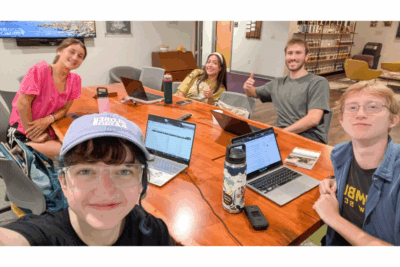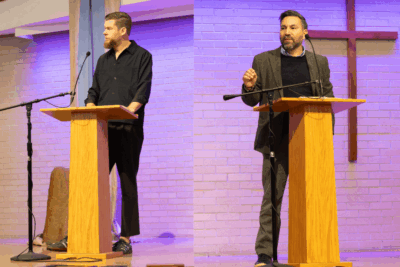Approximately 83 percent of Goshen College students are registered to vote in the midterm elections on Nov. 6, according to an email survey, with 56 percent of respondents “absolutely certain” that they will vote, and 59 percent of students have voted before.
The percentage of students who are fully committed to voting suggests a high level of Goshen College political engagement in this election. In the most recent midterm elections, in 2014, only 12 to 14 percent of eligible college or university students voted.
“I feel like voting is not only a right but a responsibility, especially as someone who is very privileged and has the ability for politics to not affect my life in very stark ways,” said senior Rowan Miller. “I must vote to exercise my desire to help others and make sure that politicians are in place to pass policy that will benefit everyone, not just the rich and elite.”
Ian Keim, a junior, said, “I feel responsible for the actions of my representatives and elected leaders because I was given the opportunity to choose them.”
A survey was sent out on Oct. 25 to all 927 enrolled students at Goshen College, and, by Oct. 29, 263 students had participated, a response rate of 28.4 percent. The survey, prepared as part of a study in Communication Research class, asked questions about how and why Goshen College students vote.
Voting at Goshen:
Fourteen percent of respondents answered that it is “more likely than not” that they will be voting. Six percent said it was a “50-50” chance, 12 percent said they “likely will not vote” and 12 percent said they definitely are not voting. Of those not voting, some reasons were not being old enough, not being a U.S. citizen, being out of country and believing their vote doesn’t matter.
“I am not voting in the upcoming midterm election because I am not old enough, but if I were 18 I would definitely vote,” said Joel Yoder, a first year. “I am not happy with this current polarized political climate where moderate voices are thrown out, but I am glad that the extreme rhetoric is drawing new people into politics — I just hope that they are looking at both sides of the issues.”
Ninety-six respondents said they would not be voting at a polling location, but rather would be voting by absentee ballot or some other method like early voting, but the majority of students will, in fact, be literally heading to the polls.
When asked to state party affiliation, 60 percent of respondents said they think of themselves as a Democrat; 13 percent answered Republican; 10 percent identify as independents; 12 percent listed themselves as having no opinion; and 6 percent selected “other,” with write-in answers that included Green party, Libertarian, moderate or Christian.
A senior, Courtney Crapser, sees the importance of not just voting straight down the line for one party.
“It is finally at a point where everything is so ridiculously out of balance that people are wanting to put a foot down and see some positive change, and one of the most effective ways is to put a good person in office,” she said. “It's the person that matters.”
Nearly half of respondents, 47 percent, strongly agreed that registering to vote was an easy process. 30 percent said they strongly agreed that their vote matters. 47 percent somewhat agreed.
Respondents were asked to rank the importance to them of the following items: education, LGBTQ+ rights, economy, climate change, immigration, abortion, gun rights or something else. Results showed that education and climate change are at the forefront of GC student’s concerns.
GC students’ patterns align with national pattern that college students lean Democratic. If the number of students who say they are voting actually do, the turn-out will exceed previous national averages.
National trends regarding student voting:
In recent years, there has been an increased focus on the role and participation of youth in elections. As pivotal midterm elections loom, this demographic is more vital than ever.
The Institute for Democracy & Higher Education at Tufts University conducted the National Study of Learning, Voting and Engagement (NSLVE) to analyze nationwide trends in young voters, especially as they relate to the 2012 and 2016 presidential elections. This study contains data from nearly 10 million enrolled students, representing over 1,000 institutions and all 50 states.
It has long been an observable trend that a large percentage of young voters (generally considered ages 18-21) do not vote. For example, in the 2014 midterm elections, only 12-14 percent of eligible college or university students voted as reported by the New York Times.
However, NSLVE found that in 2016, students did vote at a higher rate. Of the students who participated in the study, the number rose from 45.1% to 48.3% from 2012 to 2016. Also, in both elections, women voted at a higher frequency than men. Hispanic and Asian voter turnout was also higher among young voters in the 2016 election.
Young voters had the largest turnout increase from 2012 to 2016. In total, there were more than 350,000 more college age students who voted in 2016 than than 2012. That being said, in both election years, students majoring in the social sciences voted at the highest rates, and those majoring in STEM fields voted at the lowest rates.
In the Great Lakes region, which includes Indiana, there was a 3.4% increase in voter turnout from 2012 to 2016.
There have been campaigns across the country to increase voter registration ahead of the 2018 midterm elections. Young voters are especially being targeted due in part to their size — millenials are close to surpassing baby boomers as the largest living generation. With a high turnout on election day, young voters have the potential to make a strong impact at the polls
At Goshen College, there has been a flurry of activity surrounding the upcoming midterm elections, including a voter registration drive organized by the American Association of University Women (AAUW). The following section lays out details of Goshen College voting statistics among students, examining how involved students actually are.



